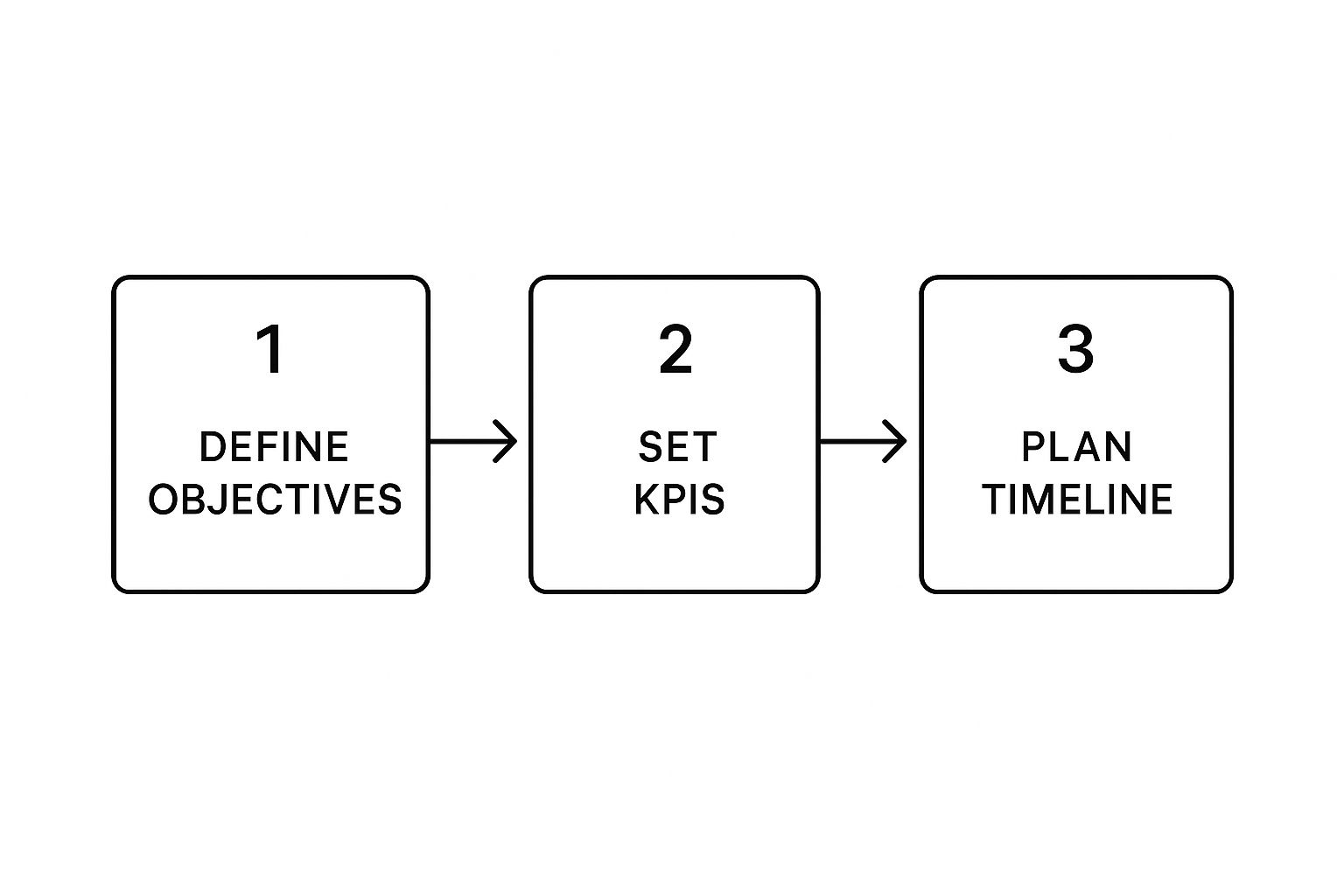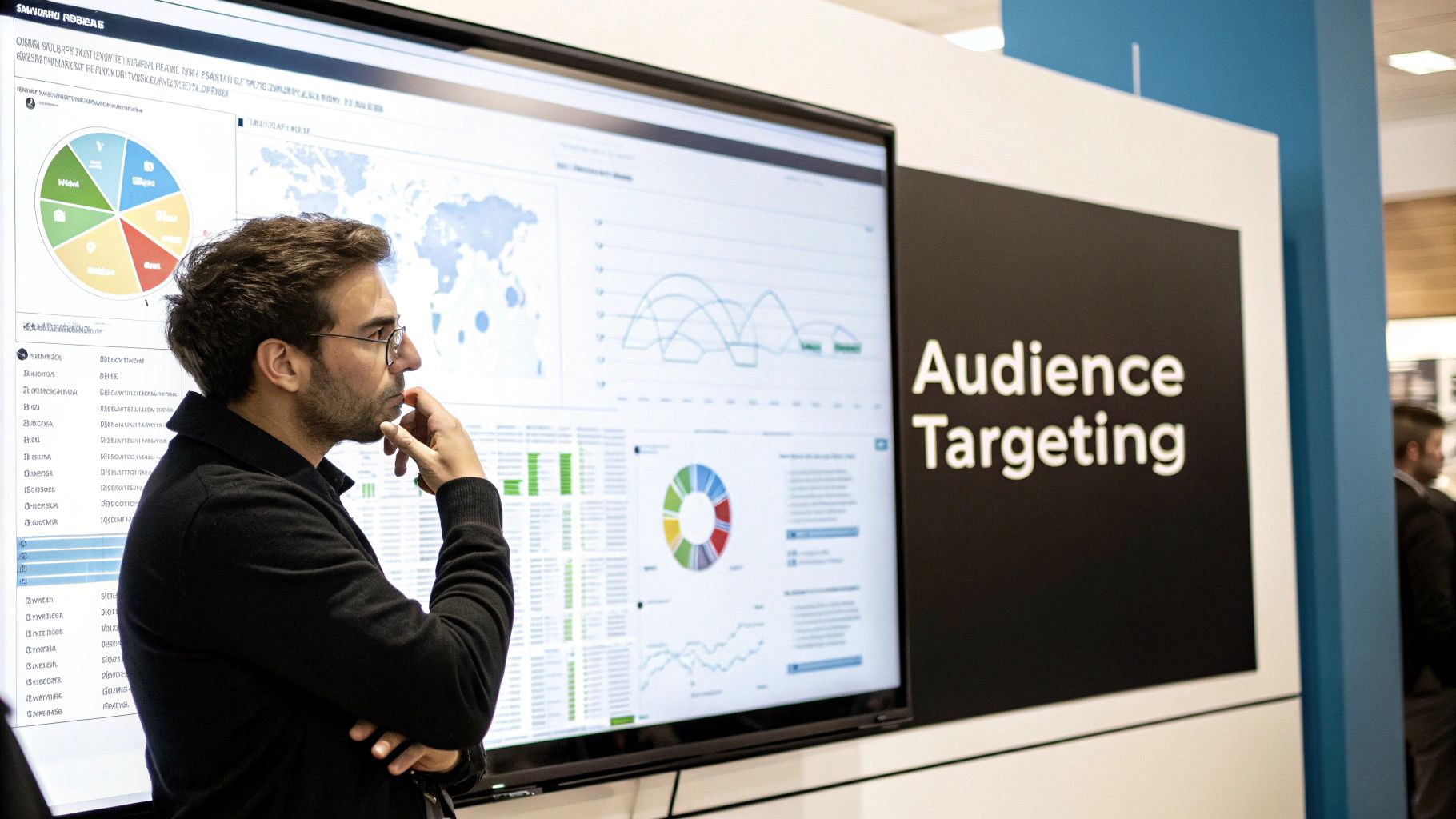
Master Successful Integrated Communications Campaigns Today
Why Integrated Communications Campaigns Win Today
Today's consumer interacts with brands across a multitude of touchpoints. These range from social media and email to websites and even in-person events. This fragmented media landscape presents a challenge. Businesses are constantly seeking ways to connect with their audience effectively. This is where integrated communications campaigns enter the picture.
Instead of relying on isolated channels, an integrated approach creates a seamless and consistent brand experience. This resonates far more powerfully with consumers. Your message is reinforced across every interaction. This builds stronger brand recognition and drives better results.
The Power of Consistent Messaging
Think of your brand as an orchestra. If each instrument plays its own tune without coordination, the result is chaotic. However, when all instruments work together in harmony, they create a beautiful symphony. Integrated campaigns work the same way. They ensure all your communication channels play the same tune. This delivers a unified and impactful message.
This consistency builds trust. It reinforces your brand identity in the minds of your audience. For example, a campaign might begin with a compelling social media teaser. This is followed by targeted email marketing that drives traffic to a dedicated landing page on your website. This cohesive customer journey creates a much stronger impression than disjointed messages.
Reaching the Right Audience at the Right Time
Integrated campaigns also enable more effective targeting. By understanding your audience's journey across various channels, you can deliver the right message at the right moment. Your communications become more relevant and engaging. This increases the likelihood of conversion.
You can also tailor your messaging to the specific platform, maximizing its impact. A snappy, visually-driven campaign might thrive on Instagram. A more detailed, informative approach could be more effective on LinkedIn.
The UK’s digital landscape emphasizes the importance of integrated online strategies. In fact, the UK's digital advertising market has seen significant growth. Total digital ad investment reached £38.07 billion in 2025. This is a 9.4% year-on-year increase. Digital advertising now accounts for over 80% of the UK's total ad spend. This highlights the shift towards online platforms for reaching audiences. Find more detailed statistics here: Learn more about UK digital advertising investment. This trend underscores the need for businesses to effectively integrate digital channels into their communication strategies. This helps capture the attention of their target audience and achieve their business goals.
Beyond Simply Using Multiple Channels
It's important to understand that simply using multiple channels doesn't automatically make a campaign integrated. True integration requires careful planning and coordination. Each channel must reinforce the others. This creates a cohesive narrative. This narrative resonates with your audience, building brand awareness and driving engagement. Ultimately, it achieves your business objectives.
The focus should be on creating a unified experience. Each touchpoint contributes to a larger, more impactful story. This holistic approach makes truly successful integrated communications campaigns stand out.
Crafting Campaigns That Actually Work Together
Moving beyond simple coordination to true integration requires a fundamental change in how we approach campaign planning. Instead of individual channels vying for attention, each element should bolster the others, creating a cohesive and impactful message. This requires a strategic framework and a deep understanding of how each channel contributes to the overall campaign narrative.
Defining a Unified Campaign Strategy
Successful integrated communications campaigns begin with clearly defined objectives. What are your goals? Increased brand awareness? Higher lead generation? Greater customer engagement? Once these objectives are set, you can develop consistent messaging across different platforms. This doesn't mean identical content everywhere; it means ensuring your core message adapts to each channel's unique context.
For example, a campaign for a new financial product might use concise, impactful language on Twitter and offer in-depth information and resources on a dedicated landing page. The key is maintaining a consistent tone and brand voice while tailoring the message to each platform's audience and format. This creates a seamless and engaging customer experience, regardless of where they interact with your brand.
Mapping the Customer Journey Across Channels
Understanding customer interaction across different touchpoints is essential for truly integrated campaigns. This means mapping the customer journey as it happens, not as an idealized path. Consider where your audience spends their time online, their preferred channels, and how they navigate between them.
This understanding allows you to create targeted interactions at each stage. A potential customer might discover your brand through a sponsored LinkedIn post, then visit your website, and later subscribe to your email newsletter. By understanding this progression, you can craft messaging that nurtures the relationship and guides them toward conversion.
The following table outlines a step-by-step approach to developing cohesive integrated campaigns.
Integrated Campaign Planning Framework
A step-by-step approach to developing cohesive integrated campaigns
| Planning Stage | Key Activities | Success Indicators |
|---|---|---|
| Define Objectives | Identify specific, measurable, achievable, relevant, and time-bound (SMART) goals for the campaign. | Increased brand awareness, higher lead generation, greater customer engagement, etc. |
| Develop Messaging | Craft core messages that resonate with the target audience and adapt to different channels. | Consistent brand voice and tone across all platforms. |
| Map Customer Journey | Understand how customers interact with the brand across different touchpoints. | Targeted interventions at each stage of the customer journey. |
| Coordinate Timing and Cadence | Plan the timing and frequency of messaging across channels. | Consistent communication that keeps the audience engaged without overwhelming them. |
This framework guides you in developing a truly integrated and high-performing campaign. By focusing on each stage, you create a cohesive strategy that resonates with your audience and drives results.

As the infographic shows, successful campaigns start with defining clear objectives. These inform the Key Performance Indicators (KPIs) used to measure progress. A detailed timeline ensures all activities are coordinated effectively. This structured approach provides a solid foundation for building a truly integrated and effective campaign.
Coordinating Timing and Cadence
Timing and cadence are vital in integrated communications campaigns. Think of it as a carefully orchestrated performance. Each channel has its role, and the timing of each interaction needs careful consideration.
The frequency of your messaging should be consistent across channels, creating a steady rhythm that keeps your audience engaged without being overwhelming. Too much communication can cause fatigue; too little can make your message get lost. Finding the right balance maximizes your integrated campaign's impact. This meticulous approach helps your campaign gain momentum and achieve its objectives.
Making Digital Channels Work In Concert

With digital channels now dominating how we communicate, successful campaigns depend on strategic coordination across multiple platforms. It's not enough to simply be everywhere; the key is to create a harmonious flow of messages that truly connect with your audience. This section explores how to achieve this powerful synergy within your integrated communications campaigns.
Building Synergies Between Digital Channels
Truly effective integrated campaigns go beyond simply repurposing content. They adapt the message to each platform's strengths. For example, a visually-driven campaign on Instagram might use stunning imagery and concise captions, while the same core message on LinkedIn could be shared through a thought-provoking article. This tailored approach maintains a consistent brand voice while optimizing for each platform's unique audience and format. This is a cornerstone of any successful integrated communication strategy.
Consider also how different channels can complement each other. A social media post can direct traffic to a specific landing page on your website, where visitors can download a valuable resource in exchange for their email address. This email address then becomes a tool for targeted email marketing, nurturing the customer relationship and reinforcing the campaign's message. This interconnected approach creates a powerful and effective integrated campaign.
Crafting Cross-Platform Narratives
Engaging integrated communications campaigns weave narratives across platforms, building upon each other rather than merely repeating the same information. This keeps your audience interested and avoids message fatigue. Imagine each channel as a chapter in a larger story, each offering a unique perspective while supporting the central theme.
Social media posts, for instance, might offer intriguing snippets of information or behind-the-scenes glimpses, sparking curiosity and driving traffic to a more comprehensive blog post or video on your website. The website content, in turn, could link to an email signup form for exclusive content or updates. Each touchpoint adds depth and value, guiding the audience through a compelling journey.
Measuring Cross-Channel Performance
Measuring the true impact of an integrated campaign requires a broader perspective than just platform-specific metrics. Focus on overall campaign KPIs that reflect the combined effect of all channels. This might include metrics like overall brand awareness, lead generation, or website traffic. For example, track how a social media campaign influences visits to your website and any resulting conversions.
A unified reporting dashboard that combines data from all your channels is essential for a comprehensive understanding of campaign performance. This allows you to see how each channel contributes to the overall success, revealing areas for improvement. Tracking cross-channel performance provides invaluable insights for optimizing future integrated campaigns, ensuring continuous improvement and maximizing effectiveness.
Leveraging Influencers Within Integrated Campaigns

Influencer marketing is no longer a separate strategy; it's a key element of successful integrated communications campaigns. This means going beyond one-off collaborations and strategically incorporating influencer partnerships into the overall communications structure. This involves careful planning for influencer selection, brief creation, content development, and, importantly, measurement.
Aligning Influencers With Campaign Objectives
Finding the right influencers is crucial. It's about identifying creators whose audience and principles truly match your campaign goals.
For instance, a sustainable fashion brand might partner with influencers recognized for their eco-friendly lifestyle and engaged audience interested in ethical shopping. This focused strategy ensures your brand message connects with the right audience, maximizing its impact and fostering genuine engagement.
Creating Effective Influencer Briefs
Crafting clear and detailed briefs is essential for productive influencer partnerships. These briefs should give creators the guidance they need while still empowering authentic and creative expression.
Think of the brief as a guide, outlining the core campaign messages, intended audience, and desired results. This framework ensures the influencer's content aligns seamlessly with the overall campaign story while honoring their unique voice.
The UK influencer market is predicted to hit £1.04 billion by 2025. This demonstrates a growing movement towards partnering with influencers to boost social purchases and engagement. This strategy is especially potent with micro-influencers, as they often cultivate authentic and focused interactions with specific audience groups. Discover more insights about influencer marketing statistics in the UK.
Content That Extends Your Campaign Messaging
Influencer-generated content should feel organic and engaging, not like a forced advertisement. The goal is to develop content that expands your campaign message naturally, utilizing the influencer's distinct style and voice.
This involves providing influencers with creative freedom within the structure of the campaign brief. This balance between direction and independence creates authentic and impactful content that resonates with their followers.
Measuring True Influencer Impact
Measuring influencer effectiveness within integrated campaigns goes beyond surface-level engagement metrics, such as likes and comments. While these offer some insights, they don't tell the complete story.
Instead, concentrate on metrics that showcase real results within the larger campaign framework. This could include website traffic stemming from influencer content, sales driven by influencer promotions, or positive shifts in brand perception among your target audience. Tracking these deeper metrics demonstrates the real value influencer collaborations bring to your campaigns and justifies investment in this important channel.
Measuring What Actually Matters
In today's competitive market, truly understanding the success of your integrated communications campaigns means looking beyond superficial metrics. Likes and shares offer a glimpse of engagement, but they don't tell the whole story. To unlock the real potential of your integrated approach, you need a robust framework that assesses performance across every channel, revealing the combined power of your efforts. Let's explore how to build this framework and harness the data to optimize your campaigns for lasting impact.
Identifying Key Metrics and KPIs
The foundation of effective measurement lies in identifying the Key Performance Indicators (KPIs) that align with your campaign objectives. If your goal is to elevate brand awareness, metrics like reach, share of voice, and brand mentions become your guiding stars. For campaigns focused on lead generation, metrics like website traffic from specific channels, lead form submissions, and conversion rates take center stage.
Choosing the right KPIs provides a compass for your campaign, illuminating your progress and empowering you to make informed decisions every step of the way. This focus ensures your efforts contribute to meaningful business outcomes and demonstrate the true value of your integrated communications strategy.
Building a Unified Reporting Dashboard
To truly grasp the performance of your integrated campaigns, it's vital to consolidate data from various sources into a unified reporting dashboard. This central hub should encompass data from social media, email marketing, website analytics, paid advertising platforms, and any other channels in your arsenal. Understanding the return on investment from influencer marketing can be a game-changer, and resources like Influencer Marketing ROI offer valuable guidance in this area.
Visualizing all your data in one place provides a panoramic view of your channels working in harmony. This reveals the synergistic effects of your integrated approach, highlighting what's working brilliantly and pinpointing areas that need a little extra attention. This consolidated view also streamlines reporting and simplifies analysis, enabling you to make data-driven decisions swiftly and confidently.
Implementing a Continuous Optimization Process
Measurement isn't a destination; it's a continuous journey. By embracing an ongoing optimization process, you can adapt your strategy based on real-time data insights. This agile approach keeps your integrated campaign dynamic and effective throughout its lifecycle, maximizing its impact and achieving outstanding results.
Regularly reviewing your unified reporting dashboard allows you to identify any underperforming channels or messages. Perhaps certain social media platforms are generating more engagement than others, or maybe your email marketing needs a boost to nurture leads effectively. These insights empower you to fine-tune your strategy, ensuring resources are allocated strategically and your campaign stays on the path to success.
Framing Integrated Campaign Measurement
The following table provides a framework to structure your measurement efforts, ensuring you're evaluating your campaign's impact with precision and purpose.
To understand how your campaigns are truly performing, you'll need to monitor key metrics at different levels, from individual channels to the overall campaign performance. This table outlines a framework to guide your measurement approach, ensuring a balanced and comprehensive view of your efforts.
Integrated Campaign Measurement Framework
Key metrics and KPIs for measuring integrated communications effectiveness
| Measurement Level | Key Metrics | Evaluation Frequency | Decision Triggers |
|---|---|---|---|
| Channel-Specific | Website traffic from each channel, engagement metrics on social media, email open and click-through rates. | Weekly | Adjust channel-specific tactics, optimize content for specific platforms. |
| Holistic Campaign | Overall brand awareness, lead generation, website traffic, conversions, return on investment (ROI). | Monthly | Adjust overall campaign strategy, reallocate budget across channels. |
This structured approach to measurement unlocks actionable insights that drive continuous improvement and maximize the impact of your integrated communications campaigns. It helps showcase the true value of integration and justify further investment in a cohesive, multi-channel strategy.
Real-World Campaigns That Nailed Integration

Let's explore how organizations in the UK have successfully implemented integrated communications campaigns. These case studies offer valuable lessons for your own campaign planning, showing how putting theory into practice can achieve outstanding results.
The National Trust: Connecting With a New Generation
The National Trust sought to engage a younger audience with its historic properties. Their integrated campaign combined visually stunning content on Instagram with interactive experiences on their website, such as virtual tours and historical information. Partnering with relevant social media influencers who shared their own National Trust adventures added another layer of engagement, successfully connecting a new generation with the Trust's rich heritage.
Tesco: Creating a Personalized Shopping Journey
Tesco’s Clubcard program became the foundation of a highly personalized, integrated campaign. By gathering data on customer preferences through online and in-store purchases, Tesco was able to tailor email offers and create targeted advertising. This data-driven approach fostered a more relevant and engaging shopping experience, strengthening customer loyalty and driving sales growth.
Sport England: Empowering Women Through #ThisGirlCan
This campaign aimed to inspire women to embrace sports, regardless of their background or fitness level. Sport England used impactful visuals and authentic stories across various channels. Encouraging user-generated content on social media through the hashtag #ThisGirlCan amplified the message. Partnerships with local gyms and sports clubs provided practical access to introductory classes and activities. The campaign’s consistent message and multi-platform approach celebrated women's active lives, leading to a significant rise in female sports participation throughout the UK.
When evaluating the success of integrated communications, measuring the right metrics is essential. Resources like this one on campaign performance metrics offer valuable insights.
Key Elements of Successful Campaigns
These examples demonstrate several core principles of effective integrated campaigns:
- Defined Goals: Each campaign established clear objectives that guided messaging and channel selection.
- Audience Insight: A deep understanding of the target audience’s preferences and behaviors allowed for tailored messaging.
- Synergistic Channels: Each communication channel played a distinct role, reinforcing the overall campaign message and delivering a cohesive experience.
- Engaging Content: Compelling and relevant content, whether visual, written, or interactive, captivated the audience and fostered participation.
Navigating Obstacles
These organizations achieved success despite facing challenges. Many overcame limited budgets by leveraging organic reach through social media and strategic partnerships. Others successfully navigated internal organizational silos by promoting collaboration across different departments.
By studying these real-world success stories and applying their best practices, you can develop integrated communications campaigns that resonate deeply with your audience and deliver exceptional results. These examples demonstrate that with strategic planning, innovative thinking, and a commitment to integration, you can elevate your communications strategy and create a lasting impression.
Future-Proofing Your Integrated Approach
The world of communication is always changing. To stay on top, your integrated communications campaigns need to be adaptable and forward-thinking. This means understanding emerging trends and creating campaigns that can easily incorporate new technologies and changing consumer behaviors.
Adapting to Emerging Trends
Several important trends are changing how brands connect with their audiences. AI-powered personalization with platforms like HubSpot is becoming more advanced, allowing for more targeted and relevant messaging. Immersive experiences, like augmented and virtual reality, offer fresh and exciting ways to engage consumers and create memorable interactions. The rise of new platforms like TikTok and the evolution of existing ones like Facebook require brands to be nimble and adaptable in their channel choices.
For example, the growing popularity of short-form video content presents both a challenge and a golden opportunity. Brands need to create captivating content that fits the format while staying true to their core message. This means understanding the unique aspects of each platform and tailoring content accordingly. Furthermore, the constantly evolving data privacy landscape requires brands to be transparent and responsible in their data collection and usage. This builds consumer trust and ensures compliance with new regulations.
Building Adaptable Campaign Architectures
Future-proofing your integrated communications campaigns means creating flexible frameworks that can grow and change without losing their core strength. This means developing modular campaign structures where individual parts can be adjusted or replaced as needed.
It’s similar to building with LEGOs – you have a foundation (your campaign objectives and core messages), but the individual pieces (specific channels and tactics) can be rearranged and reconfigured to suit the changing environment. This adaptability is key to staying effective as consumer behaviors and technologies evolve.
Maintaining Messaging Coherence in a Dynamic Environment
As new channels and technologies appear, maintaining a consistent brand voice and message across all touchpoints becomes even more vital. This means having a clear brand identity and messaging guidelines that can be applied across different platforms and formats.
Think of your brand message as a connecting thread woven through your integrated campaign. Even as the specific channels and tactics change, this thread keeps everything tied together. This consistency builds trust with your audience and reinforces your brand identity.
Practical Approaches to Future-Proofing
Here are a few practical steps to ensure your integrated approach remains effective for the long haul:
-
Embrace a data-driven approach: Use data and analytics tools like Google Analytics to understand audience behavior, track campaign performance, and identify emerging trends. This lets you make informed decisions about channel selection, messaging, and how you use your resources.
-
Foster a culture of experimentation: Be open to trying new things, testing different approaches, and learning from what doesn't work. The communication world is always in motion, so a willingness to experiment is vital for staying ahead.
-
Invest in continuous learning: Keep up with the newest trends, technologies, and best practices in integrated communications. This lets you adapt your strategies and stay competitive.
-
Prioritize flexibility and agility: Build adaptable campaign structures that can be easily adjusted. This allows you to respond quickly to new trends and shifts in consumer behavior.
Ready to take your integrated communications campaigns to the next level? Contact Blackbird Digital today. We specialize in innovative digital PR, securing placements in top-tier publications, and crafting custom strategies that drive organic growth. Let us help you dominate search rankings and grab the market’s attention.




